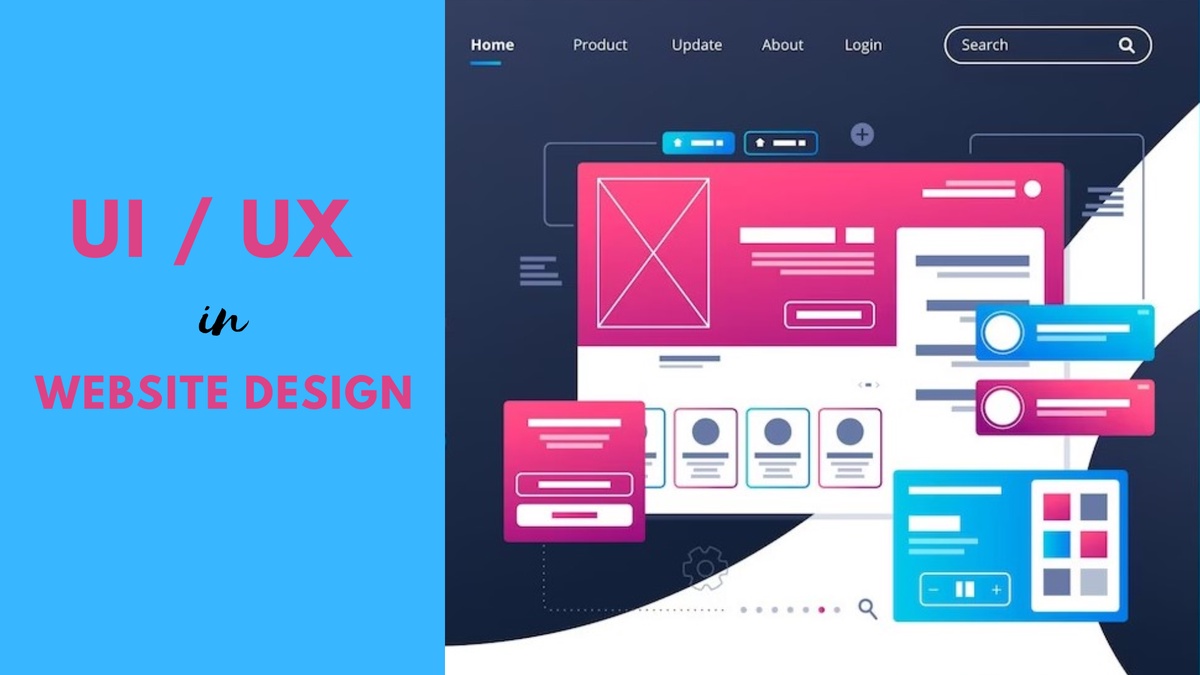Every modern business or person who wants to impact the web needs a professional website. The success and efficiency of a website are directly tied to the quality of the design's user interface (UI) and user experience (UX).
In contrast to UX, which is concerned with how well a website delivers on its users' expectations and requirements, UI is concerned with how those aspects and services look and feel.
Conversion rates may rise by as much as 400% with strong UX and as much as 200% with decent UI.
Web designers may make an indelible impression on site visitors by tapping into the limitless possibilities of user interface and user experience design.
This article delves into the numerous methods and recommendations that may assist in bringing out the finest in UI/UX website design.
1. Understanding the Importance of UI/UX in Website Design
● Defining UI and UX
The term "User Interface" (or "UI") is used to describe the aesthetics and interactivity of a website. This includes things like menus, forms, and buttons. It's concerned with the visual appeal and usability of the website. However, UX (User Experience) refers to the user's entire impression of the website, including their level of satisfaction with its usability and how well it meets their needs.
● The Significance of UX/UI in website design
User interface and user experience design are crucial elements of every successful website. A well-developed user interface will have an attractive aesthetic and be easy to navigate. Consistency in layout, color palette, typeface choice, and branding make for a unified and exciting visual presentation.
With a well-designed user interface (UX), users may quickly locate what they need, take the activities they want, and leave the site satisfied. This includes clear information architecture, a well-organized layout, and easy navigation.
● Impact on user engagement and conversion rates
UI/UX directly influences user interaction and action. Users are more inclined to click around and spend time on a site with an easy-on-the-eyes user interface.
Visitors stay on your site longer and are less likely to bounce because of a simple and user-friendly user interface. User interface and user experience design boost conversion rates by improving trust and confidence in a business.
A website's design accounts for 94% of users' first judgments of a brand. Users who enjoy interacting with a website are likely to do the intended activities, such as buying something, filling out a form, or signing up for a service.
2. Principles of Effective UI/UX Design
● Consistency and familiarity
Consistency and familiarity are essential in user interface and user experience design. Colors, fonts, and buttons that always seem the same give consumers a sense of comfort and familiarity with the interface. This eases the mental burden of website development and increases its usability.
● Clarity and simplicity
Clarity and simplicity are paramount when designing a user interface or user experience. A website's usability depends on its visitors comprehending and utilizing its contents quickly. The simplification of challenging tasks and the supply of clear instructions may increase user satisfaction.
● Accessibility and inclusivity
Designing for accessibility and inclusivity should be top UI/UX project priorities. Websites must be accessible to people with a wide range of physical abilities.
This may be done by including keyboard navigation choices, employing color schemes with enough contrast, and offering alternate text for pictures. All users, regardless of ability, should easily navigate and utilize the site thanks to inclusive design.
● Responsiveness and adaptability
Today's multi-device environment places a premium on responsiveness and adaptability. User interface and user experience designs should be "responsive" or flexible enough to work well across various devices and display sizes. This guarantees that the site's functionality and aesthetics will be preserved across different screen sizes.
● Visual Hierarchy and effective information architecture
A well-designed user interface (UI) may increase a website's conversion rate by as much as 200 percent.
A well-organized visual hierarchy and a well-thought-out information architecture facilitate finding the information a user needs.
Users can more quickly find the information they need and grasp the connections between various pieces of material if organized logically and hierarchically with descriptive headings, subheadings, and other visual cues.
3. UI/UX Techniques to Enhance Website Design
● Intuitive navigation and user flow
Making sure visitors can quickly and easily access the content they need requires designing a navigation system that is both obvious and easy to use. Website navigation is made easier with well-defined user flows.
● Seamless and visually appealing layout design
Users are more likely to stick around and form a favorable impression if they find the layout aesthetically pleasing. Spacing, alignment, and visual hierarchy make a website user-friendly and ensure crucial content is front and center.
● Effective use of color, typography, and imagery
The website's look has been improved by paying close attention to its color scheme, font, and photos. Using color schemes and styles matching the brand personality and high-quality pictures can make the user experience more uniform and attractive.
● Microinteractions for enhanced user engagement
Microinteractions are little animations or feedback that react to user actions and give visual clues. Spirits, like those shown as page loads, make using a website more fun and interesting.
● Optimizing website performance and loading times
Websites that load quickly get higher marks from users and suffer lower bounce rates. Some strategies to speed up a website include coding simplification, image optimization, and caching.
● Mobile-first design and responsive web development
Since mobile devices are growing, websites must be made with small screens in mind. Responsive website design company Orange County aims to create a website that works appropriately on various devices with varying screen sizes.
4. Integrating UI/UX with Branding and Content Strategy
● Consistent branding across the website
The website's UI UX design should reflect and maintain the brand's visual style. Using the same color scheme, typeface, and other visual cues consistently helps build brand awareness and loyalty.
● Using UI/UX to reinforce brand values and identity
The ideals and personality of a brand may be successfully conveyed through user interface and user experience design. The website may offer a consistent brand experience that is meaningful to customers by including design aspects that reflect the business's personality, such as minimalist or whimsical aesthetics.
● Aligning content with UI/UX to enhance user experience
The UI/UX of a website should go well with its content plan. Users have a better time when they can easily find the information they need thanks to well-organized plans, easy access, and clear signs. Storytelling and other forms of interactivity can also be used to get people interested in the material.
● Personalization and customization for improved engagement
Users may have a one-of-a-kind experience thanks to custom UI/UX design. The website's ability to adapt to each visitor's tastes and preferences via storing and other personalization settings increases its potential for attracting and retaining visitors.
5. Conducting User Research and Testing
● Importance of user research in UI/UX design
Conducting user research provides designers with valuable insight into the wants, requirements, and habits of their intended users. It helps designers decide based on what their users want, needs and motivates them.
● Gathering user feedback and conducting usability tests
User surveys, interviews, and usability tests are all effective methods for gaining insight into the user experience and validating design choices via user validation. "Usability tests" can be used to find usability problems and study how users act.
● Implementing iterative design based on user insights
The design process is iterative based on user input and research. With user feedback, designers may fine-tune the user interface and experience to serve their target audience better.
● Analyzing user behavior and making data-driven design decisions
Quantitative insights into how people engage with the website may be gained by analyzing statistics on user behavior, such as heatmaps or click-through rates. This information may be used to make better design choices, set improvement priorities, and fine-tune the UI/UX to better meet the target audience's needs.
6. Emerging Trends and Technologies in UI/UX Design
● Voice User Interface (VUI) and conversational design
VUI and simple design are becoming increasingly commonplace as voice assistants like Siri and Alexa gain popularity. Voice-controlled interfaces benefit from improved usability when designed with natural language processing and intuitive voice interactions in mind.
● Augmented Reality (AR) and Virtual Reality (VR) experiences
Both AR and VR allow for very realistic and interactive environments. User interface and user experience design in this context includes making interfaces that are easy to use and aesthetically pleasing while boosting user engagement and interaction by naturally blending virtual and real-world aspects.
● AI-powered chatbots and virtual assistants
Chatbots and AI-powered virtual assistants employ NLP and machine learning to provide unique and engaging services to each user. Conversational flows, visual representations, and intuitive interactions are the primary emphasis of UI/UX design for these systems.
● Integration of motion and animation in UI/UX design
Sites and programs benefit significantly from the addition of action and animation. Well-crafted energy or movement may serve as a visual signal for the user, help direct their focus, and improve their overall experience quality.
● Progressive Web Applications (PWAs) and the Future of web design
Progressive web apps (PWAs) give an optimal hybrid experience using the best online and mobile app technologies on any platform. As a result of prioritizing adaptable and adaptive design principles, offline capability, and app-like interactions, PWAs provide enhanced user experiences.
7. Case Studies: Examples of Exemplary UI/UX in Website Design
● Airbnb: Streamlined booking experience and user-generated content
The user-friendly interface and user experience of Airbnb make it simple to browse available lodgings and reserve a room. The user-friendly search interface, tailored suggestions, and user-generated material like ratings and reviews contribute to higher trust and better decision-making.
● Apple: Seamless and visually stunning product showcase
Apple's website has an intuitive and aesthetically pleasing UI/UX design consistent with the company's minimalist philosophy. The attention to detail in the design, high-resolution product photos, and user-friendly interface all add up to an exciting and satisfying shopping experience. The website does an excellent job of showcasing critical aspects of Apple's products, so visitors can get a feel for what the company offers.
● Slack: Intuitive collaboration and communication platform
Slack's user interface and user experience were designed with easy teaming and communication in mind. The platform's user interface (UI) is created to make practical collaboration via channels, threaded conversations, and real-time messaging easier. The intuitive layout with straightforward navigation and descriptive labels dramatically benefits the user experience.
● Spotify: Personalized recommendations and engaging music discovery
Spotify's user interface and experience are geared toward one-on-one music curation and exploration. The platform's user interface provides curated playlists, individualized recommendations, and straightforward search tools, resulting in an intimate and individualized musical experience. Album art, eye-catching animations, and smooth transitions add to a visually stunning UI/UX design.
Final words
User interface and user experience design have enormous potential and are still developing. Websites that capture users' attention, provide a positive experience, and give the required results may be created using sound UI/UX ideas, methods, and technology.
Designers may better adapt their work to their audience's changing wants and requirements using a user-centered approach and continual user research and testing. In the end, web designers can define the Future of website design by embracing the limitless potential of UI/UX to create immersive digital experiences that make a lasting impression on visitors.


No comments yet